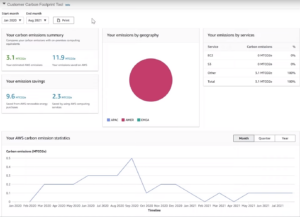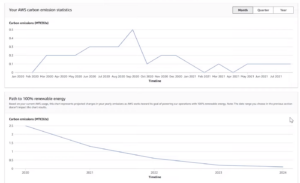
The Impact of Cloud Migration on Carbon Footprint: AWS Cloud Case Study
Statistics indicate that migrating operations to the public cloud and prioritizing cloud-based applications can potentially reduce global emissions and energy consumption by up to 20%.
To underscore the significance of this point, consider various government initiatives:
- The UK government aims to achieve zero greenhouse gas emissions by 2050.
- The US government plans to reach zero emissions by 2050.
- The European climate law sets a target for a 55% reduction in greenhouse gas emissions by 2030.
- The European Union aims for zero emissions by 2050.
When examining the energy consumption of global data centers, it becomes apparent that it nearly matches the annual energy usage of Spain. Transitioning towards a green cloud model could make a substantial difference by decreasing global CO2 emissions. This shift could potentially reduce total IT emissions by 5.9%, equivalent to removing 22 million cars from the road.
A case study on Google’s Energy Efficiency in the Cloud reveals that by switching to Google Apps, the company reduced office computing costs, energy usage, and carbon emissions by 65-90%.
Another case study indicates that businesses using Gmail have decreased the environmental impact of their email services by up to 98% compared to those running email on local servers.
Driving Sustainability Using AWS or Other Cloud Platforms
Tech giants such as Google, Amazon, and Microsoft are developing tools to measure the environmental impact of everything from cloud computing to app development. Incorporating these tools can lead to potential savings and a positive sustainability impact.
Tools provided by cloud providers offer the opportunity to track the carbon emissions of AWS usage. For instance, the AWS Customer Carbon Footprint Tool enables users to track the carbon emissions of their AWS usage. This tool uses easy-to-understand data visualizations to provide customers with historical carbon emissions, evaluate emission trends as AWS usage evolves, approximate the estimated carbon emissions avoided by using AWS instead of an on-premises data center, and review forecasted emissions based on current use.
Below is a screenshot of the AWS Customer Carbon Footprint tool with an emission-saving summary for one of Gart Solutions‘ customers.

The forecasted emissions are based on current usage and illustrate how a customer’s carbon footprint will change as AWS progresses toward powering its operations with 100 percent renewable energy by 2025 and reaching net-zero carbon by 2040.
Gart has already initiated the path to 100% renewable energy (below is the screenshot).

At Gart, as part of our Environmental Sustainability program, we check and implement the following DevOps Initiatives:
- Energy-Efficient Infrastructure
Carefully selecting infrastructure with a focus on energy-efficient practices, renewable energy sources, and high-efficiency hardware.
- Dynamic Scaling Strategies
Incorporating intelligent scaling strategies in automation to respond to workload fluctuations and prevent unnecessary resource consumption.
- Optimized Containerization
Building lightweight and efficient container images, along with efficient orchestration systems like Kubernetes, to reduce deployment energy footprint.
- Configuration Management for Efficiency
Using tools like Ansible or Puppet to automate configuration tasks, ensuring consistency and efficiency across infrastructure components. - Green Deployment Strategies
Minimizing disruption and energy consumption during updates through techniques like canary deployments, blue-green deployments, and feature toggles. - Monitoring and Resource Optimization
Continuously monitoring infrastructure performance and resource utilization to identify opportunities for optimization. - Infrastructure as Code (IaC)
Embracing IaC to define and manage infrastructure using code, enhancing efficiency and reducing the likelihood of misconfigurations.
- Team’s Education and Awareness
Fostering a culture of responsibility by creating awareness and educating team members about the environmental impact of technology operations.
Summary
Cloud migration can potentially reduce emissions by up to 20%. Paired with government initiatives worldwide aimed at achieving zero greenhouse gas emissions by 2050, the importance of environmental sustainability in the commercial sector is emphasized.
Case studies from major cloud providers highlight the substantial reduction in office computing costs, energy use, and carbon emissions achieved by adopting cloud-based solutions. The transition to cloud services is a crucial strategy to align with environmental goals.
Gart Solutions, as a DevOps and Cloud Services provider, is actively engaged in implementing environmental sustainability program initiatives to further minimize environmental impact. These initiatives include energy-efficient infrastructure, dynamic scaling strategies, optimized containerization, green ops deployment strategies, and others, fostering a culture of responsibility and awareness regarding the environmental impact of technology operations.